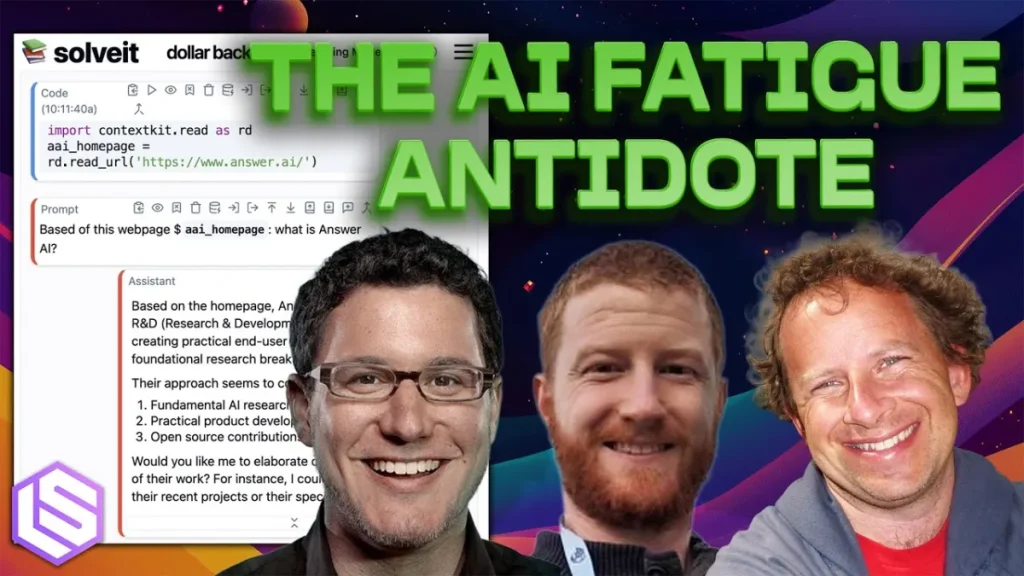October 5, 2025, 8:47 am IDT
The prevailing narrative in AI development often champions the relentless pursuit of Artificial General Intelligence, frequently leading to a “gold rush” mentality that overlooks practical applications and innovative product directions. However, at the Latent Space podcast, Answer.ai co-founders Jeremy Howard and Eric Ries, alongside Johno Whitaker, unveiled Solveit, a platform challenging this conventional wisdom by focusing on augmenting human capability through a deeply integrated, iterative, and comprehensible AI experience.
Eric Ries, the progenitor of the Lean Startup methodology, articulated the genesis of Answer.ai, stating, “We just felt like there were a series of research and product directions that weren’t being explored… if we took the thesis of AI’s transformative potential seriously.” This conviction led to a deliberate choice: to build a lean, focused team. Jeremy Howard revealed their audacious constraint: “This group of… 9 people… have built a pretty transformational and complex piece of software… doing all the DevOps and sysadmin and everything using our own tools that we built in-house.” This deep vertical integration, born from necessity, has yielded a uniquely agile and productive R&D lab, challenging the notion that massive teams and external dependencies are prerequisites for groundbreaking AI.
Solveit is fundamentally an embodiment of Polya’s classic problem-solving methodology: Understand the Problem, Devise a Plan, Carry Out the Plan, and Look Back and Reflect. This structured approach, combined with Answer.ai’s core philosophy, places the human firmly as “the agent driving the process end-to-end,” as Ries emphasized. Unlike black-box AI systems, Solveit prioritizes explainability and human control, breaking down complex tasks into small, iterative, and understandable steps. This is critical because, as Howard noted, “The AI must be able to see everything that we can see, exactly like we see it. And vice-versa. We need to be able to see everything that the AI can see.” This bidirectional transparency ensures that users not only leverage AI’s power but also deeply comprehend its outputs, fostering learning and trust.
The platform’s design facilitates a “personal software revolution,” moving beyond the one-size-fits-all SaaS model. Solveit users operate within a persistent Linux Docker container, essentially their own hackable virtual private server, instantly provisioned and accessible via a unique URL. This environment allows for the installation of any software, creation of servers, and the running of complex operations without the typical overhead of cloud infrastructure. Johno Whitaker demonstrated this by building a fragrance search application, while Eric Ries showcased how he leverages Solveit to draft content for his upcoming book, highlighting its utility for diverse, non-coding tasks. This composability, where simple Python functions or even entire web components can be seamlessly integrated and leveraged by the AI, empowers users to create bespoke tools for their specific needs, transforming workflows across a wide array of applications.
The iterative feedback loop is another cornerstone. Users can edit past messages, branch conversations, and immediately execute code or text, observing real-time results. This dynamic interaction fosters a deeper understanding of the problem and the AI’s capabilities, mitigating the “soporific state” Ries warns against, where users passively accept AI-generated content without critical engagement. The ability to “guide” the AI by correcting its responses within the dialogue is particularly potent, ensuring the model’s output remains aligned with human intent and preventing the accumulation of errors. This active, human-guided refinement is what truly unlocks the AI’s potential as a productive co-pilot.
Answer.ai’s Solveit represents a compelling vision for the future of human-AI collaboration. It redefines productivity by integrating AI into a transparent, iterative, and deeply customizable workflow, empowering individuals and small teams to achieve disproportionate impact across diverse domains.

